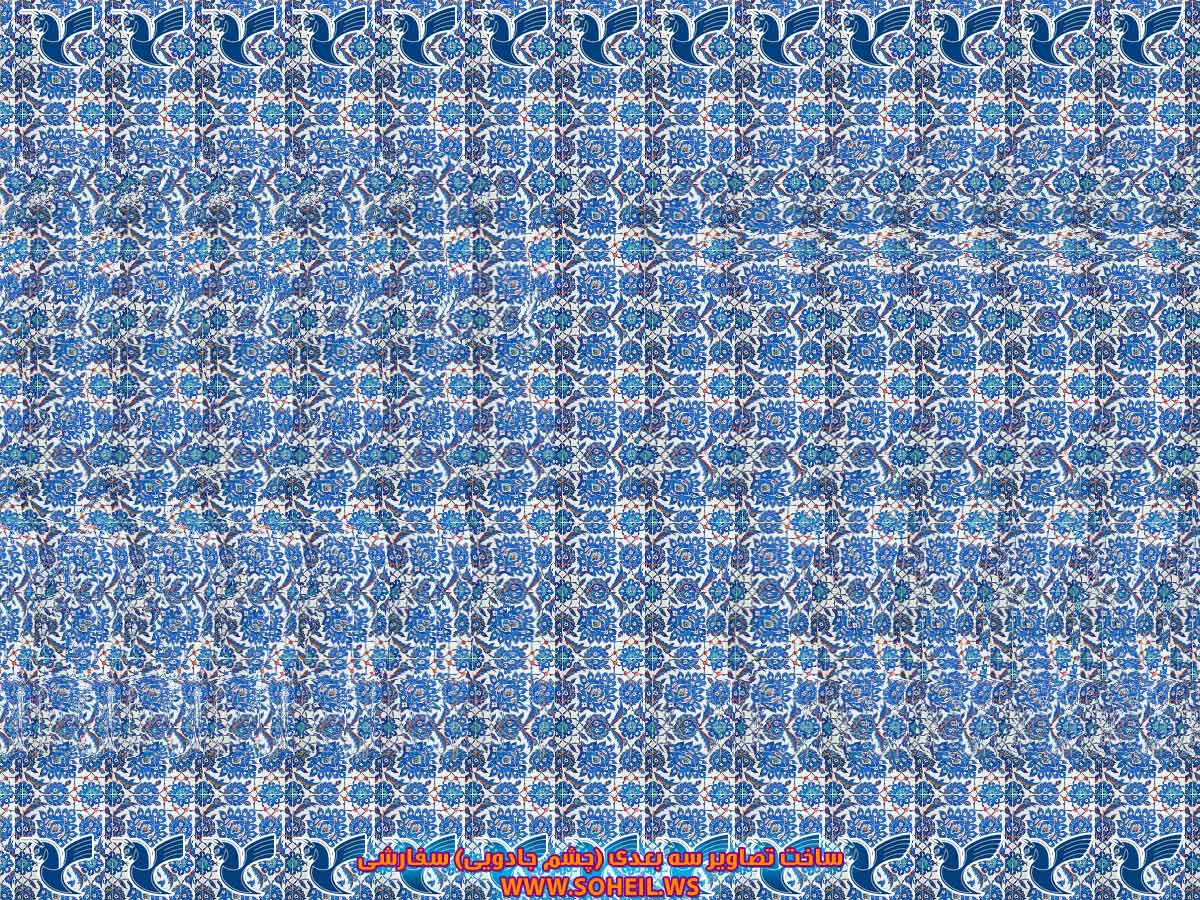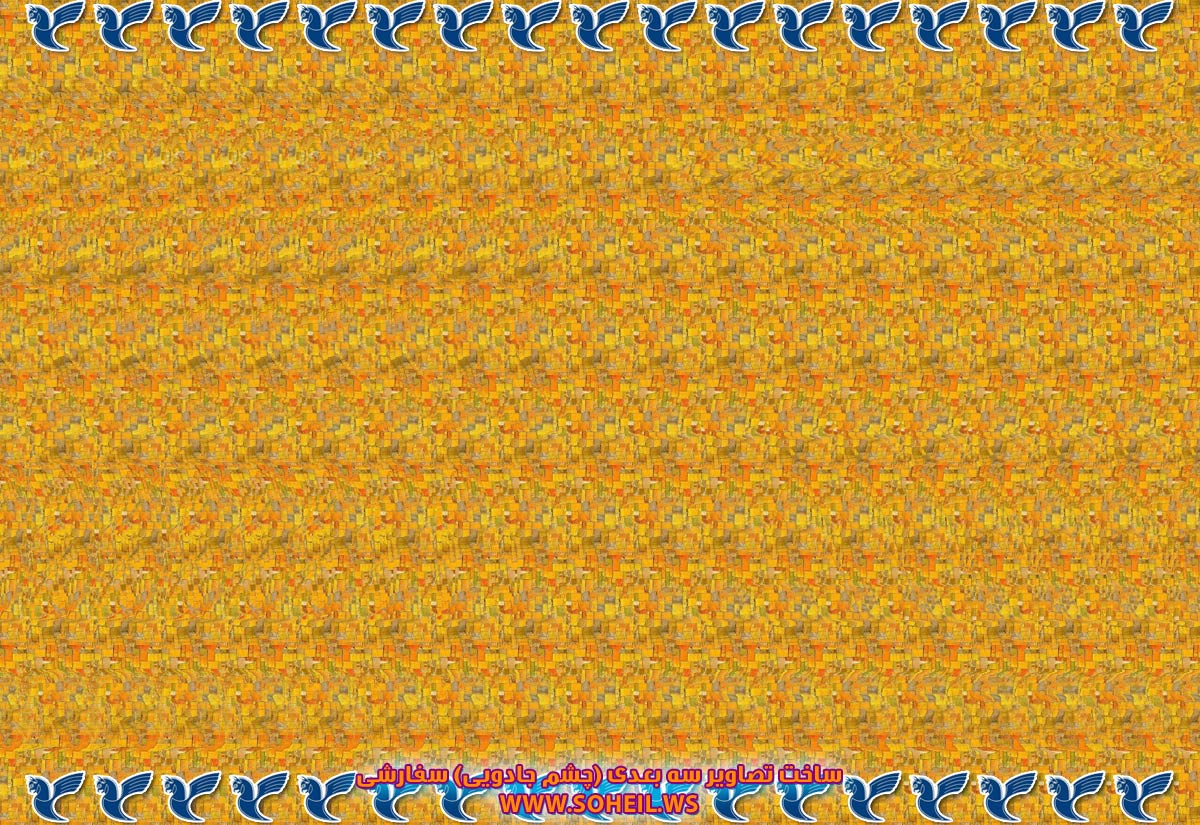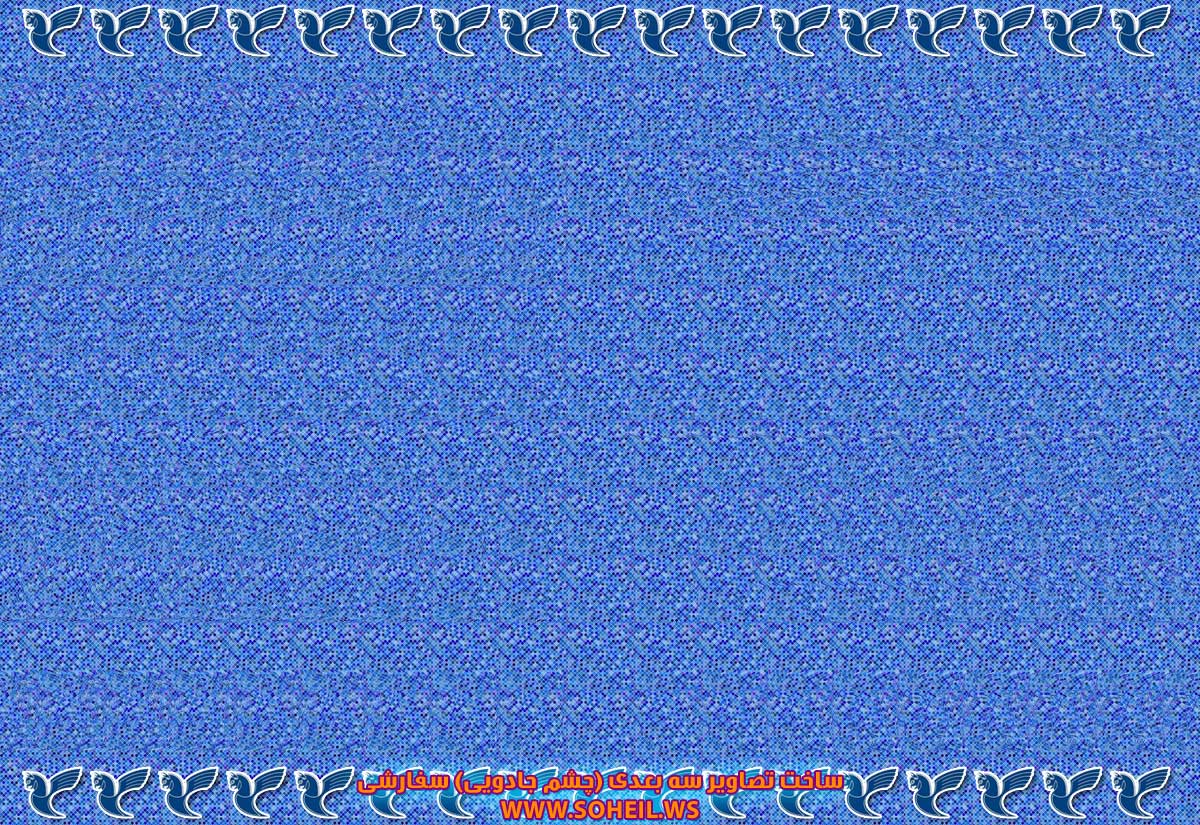● تصاویر سه بعدی / چشم جادویی●
:راهنمای دیدن تصاویر سه بعدی/ چشم جادویی
به
دونقطه قرمز تصویر ذیل دقت کنید.حال-چشم خود را به نقطه ای در پشت مانیتور
خیره کنید-سپس با همین- حالت نگاه راقفل کنید-، نگاه خود را به 2 نقطه
قرمز تصویر ذیل برگردانید.در واقع بطور ناخود آگاه یا اگاهانه باید
درحالیکه 2 نقطه را میبینید ،چشمان خود را کمی بهم نزدیک کنید که این همان
موقعیتی است که 2 چشم برای دیدن مناظر دورتر بخود میگیرند و کاملا طبیعی
است
برای مثال تصویر پایین را در جایی ذخیره کنید .آنرا به گوشی همراه یا تبلت منتقل کنید و در همین اندازه اصلی 1:1نمایش دهید
سپس
به منظره پشت وسیله نمایشگر(گوشی-تبلت...)خیره بشوید و چشمتان را در همین
حالت نگه دارید و سپس به عکس که در آن نمایش داده اید نگاه کنید.الان باید
2 نقطه بصورت سه تایی ببینید و زمینه آبی رنگ الان در حالت سه بعدی قرار
گرفته و می بینید که دو دایره قرمز رنگ با زمینه آبی فاصله گرفته اند که
حالت سه بعدی را صحیح می بینید
سعی دارم در آینده تصاویر سه بعدی بیشتر با تنوع بیشتر در این بلاگ پست نمایم.پس لطفا باز هم سری به بلاگ من بزنید
تاریخچه
به نقل از سایت ویکی پدیا
در سال ۱۹۷۰ م. ماسایوکی ایشو هنرمند ژاپنی با ستفاده از چهار نوار موازی به هم پیوسته از الگوهای تصادفی نخستین استریوگرام تک تصویری یا اتواستریوگرام (همان چیزی که ما تصویر سه بعدی جادویی مینامیم) را پدید آورد. در ۱۹۷۴ م. یک سویسی این کار را با شش نوار کرد. هنر این دو تن بیش از هر چیز در این بود که با استفاده از دست و بدون دخالت رایانه ظرافتهای نهفته در این تصاویر را پدید میآوردند. در سال ۱۹۷۹ م پروفسور کریستوفر تایلر روانشناس انگلیسی با استفاده از امکانات رایانهای و همکاری کلارک مائورین برنامه نویس تصاویری از این دست پدید آورد در سال ۱۹۹۱ م یک آلمانی با تولید تصاویر متنوعی از این دست این امر را به سوی تجاری شدن سوق داد و از آن پس پوسترها و مجالت و کتابهای بی شماری از این دست چاپ شدند.
.
سعی دارم در آینده تصاویر سه بعدی بیشتر با تنوع بیشتر در این بلاگ پست نمایم.پس لطفا باز هم سری به بلاگ من بزنید
تاریخچه
به نقل از سایت ویکی پدیا
در سال ۱۹۷۰ م. ماسایوکی ایشو هنرمند ژاپنی با ستفاده از چهار نوار موازی به هم پیوسته از الگوهای تصادفی نخستین استریوگرام تک تصویری یا اتواستریوگرام (همان چیزی که ما تصویر سه بعدی جادویی مینامیم) را پدید آورد. در ۱۹۷۴ م. یک سویسی این کار را با شش نوار کرد. هنر این دو تن بیش از هر چیز در این بود که با استفاده از دست و بدون دخالت رایانه ظرافتهای نهفته در این تصاویر را پدید میآوردند. در سال ۱۹۷۹ م پروفسور کریستوفر تایلر روانشناس انگلیسی با استفاده از امکانات رایانهای و همکاری کلارک مائورین برنامه نویس تصاویری از این دست پدید آورد در سال ۱۹۹۱ م یک آلمانی با تولید تصاویر متنوعی از این دست این امر را به سوی تجاری شدن سوق داد و از آن پس پوسترها و مجالت و کتابهای بی شماری از این دست چاپ شدند.
.
گالری معرفی آثار هنری من/My ARTWORK Gallery
GUIDE TO WATCH 3D MAGIC EYE, IMAGES:
look
to 2 red dots on image.now look at a point beyond your monitor or
display device.with keeping eyes on this state (lock eye positions) back
on the 2 red dots on below image.this is same state you look to far
away landscapes.( 2 eyes come closer together). and this is normal.
Ie.save
below image .the load it in a mobile or tablet .the scale must be
1:1.then gaze on a scene beyond the display.lock your eyes state in this
position.then look to image again.now you mus see the 2 red dots in 3
dots now.this show you see 3D image correctly now.and red points are now
distanced to the blue texture in image.it resembles a simple 3D state .
i try to post various magic-eye images in this blog.so please recheck again my blogs.
thanks for your visit.
History
from wikipedia website.
In 1838, the British scientist Charles Wheatstone published an explanation of stereopsis (binocular depth perception) arising from differences in the horizontal positions of images in the two eyes. He supported his explanation by showing pictures with such horizontal differences, stereograms, separately to the left and right eyes through a stereoscope he invented based on mirrors. When people looked at these flat, two-dimensional pictures, they experienced the illusion of three-dimensional depth.
Between 1849 and 1850, David Brewster, a Scottish scientist, improved the Wheatstone stereoscope by using lenses instead of mirrors, thus reducing the size of the device.
Brewster also discovered the "wallpaper effect". He noticed that staring at repeated patterns in wallpapers could trick the brain into matching pairs of them as coming from the same virtual object on a virtual plane behind the walls. This is the basis of wallpaper-style "autostereograms" (also known as single-image stereograms).
In 1939 Boris Kompaneysky published the first random dot stereogram containing an image of the face of Venus,intended to be viewed with a device.
In 1959, Bela Julesz,[ a vision scientist, psychologist and MacArthur Fellow, invented the random dot stereogram while working at Bell Laboratories on recognizing camouflaged objects from aerial pictures taken by spy planes. At the time, many vision scientists still thought that depth perception occurred in the eye itself, whereas now it is known to be a complex neurological process. Julesz used a computer to create a stereo pair of random-dot images which, when viewed under a stereoscope, caused the brain to see 3D shapes. This proved that depth perception is a neurological process.
Japanese designer Masayuki Ito, following Julesz, created a single image stereogram in 1970 and Swiss painter Alfons Schilling created a handmade single-image stereogram in 1974, after creating more than one viewer and meeting with Julesz. Having experience with stereo imaging in holography, lenticular photography, and vectography, he developed a random-dot method based on closely spaced vertical lines in parallax.
In 1979, Christopher Tyler of Smith-Kettlewell Institute, a student of Julesz and a visual psychophysicist, combined the theories behind single-image wallpaper stereograms and random-dot stereograms (the work of Julesz and Schilling) to create the first black-and-white "random-dot autostereogram" (also known as single-image random-dot stereogram) with the assistance of computer programmer Maureen Clarke using Apple II and BASIC. This type of autostereogram allows a person to see 3D shapes from a single 2D image without the aid of optical equipment. In 1991 computer programmer Tom Baccei and artist Cheri Smith created the first color random-dot autostereograms, later marketed as Magic Eye.
In 1838, the British scientist Charles Wheatstone published an explanation of stereopsis (binocular depth perception) arising from differences in the horizontal positions of images in the two eyes. He supported his explanation by showing pictures with such horizontal differences, stereograms, separately to the left and right eyes through a stereoscope he invented based on mirrors. When people looked at these flat, two-dimensional pictures, they experienced the illusion of three-dimensional depth.
Between 1849 and 1850, David Brewster, a Scottish scientist, improved the Wheatstone stereoscope by using lenses instead of mirrors, thus reducing the size of the device.
Brewster also discovered the "wallpaper effect". He noticed that staring at repeated patterns in wallpapers could trick the brain into matching pairs of them as coming from the same virtual object on a virtual plane behind the walls. This is the basis of wallpaper-style "autostereograms" (also known as single-image stereograms).
In 1939 Boris Kompaneysky published the first random dot stereogram containing an image of the face of Venus,intended to be viewed with a device.
In 1959, Bela Julesz,[ a vision scientist, psychologist and MacArthur Fellow, invented the random dot stereogram while working at Bell Laboratories on recognizing camouflaged objects from aerial pictures taken by spy planes. At the time, many vision scientists still thought that depth perception occurred in the eye itself, whereas now it is known to be a complex neurological process. Julesz used a computer to create a stereo pair of random-dot images which, when viewed under a stereoscope, caused the brain to see 3D shapes. This proved that depth perception is a neurological process.
Japanese designer Masayuki Ito, following Julesz, created a single image stereogram in 1970 and Swiss painter Alfons Schilling created a handmade single-image stereogram in 1974, after creating more than one viewer and meeting with Julesz. Having experience with stereo imaging in holography, lenticular photography, and vectography, he developed a random-dot method based on closely spaced vertical lines in parallax.
In 1979, Christopher Tyler of Smith-Kettlewell Institute, a student of Julesz and a visual psychophysicist, combined the theories behind single-image wallpaper stereograms and random-dot stereograms (the work of Julesz and Schilling) to create the first black-and-white "random-dot autostereogram" (also known as single-image random-dot stereogram) with the assistance of computer programmer Maureen Clarke using Apple II and BASIC. This type of autostereogram allows a person to see 3D shapes from a single 2D image without the aid of optical equipment. In 1991 computer programmer Tom Baccei and artist Cheri Smith created the first color random-dot autostereograms, later marketed as Magic Eye.
My ARTWORK Gallery

● نمونه تصویر سه بعدی (چشم جادویی) ساخته شده با لوگوی هما ●
تصاویر برای نمایش در سایت کوچک نمایی شده اند روی عکس ها کلیک کنید



تاریخچه ●
به نقل از سایت ویکی لیکس ●
به نقل از سایت ویکی لیکس ●
در سال ۱۹۷۰ م. ماسایوکی ایشو هنرمند ژاپنی با ستفاده از چهار نوار
موازی به هم پیوسته از الگوهای تصادفی نخستین استریوگرام تک تصویری یا
اتواستریوگرام (همان چیزی که ما تصویر سه بعدی
جادویی مینامیم) را پدید آورد. در ۱۹۷۴ م. یک سویسی این کار را با شش
نوار کرد. هنر این دو تن بیش از هر چیز در این بود که با استفاده از دست و
بدون دخالت رایانه ظرافتهای نهفته در این تصاویر را پدید میآوردند. در
سال ۱۹۷۹ م پروفسور کریستوفر تایلر روانشناس انگلیسی با استفاده از امکانات
رایانهای و همکاری کلارک مائورین برنامه نویس
تصاویری از این دست پدید آورد در سال ۱۹۹۱ م یک آلمانی با تولید تصاویر
متنوعی از این دست این امر را به سوی تجاری شدن سوق داد و از آن پس پوسترها
و مجالت و کتابهای بی شماری از این دست چاپ شدند
تصاویر سه بعدی علاوه بر جنبه سرگرمی
، می تواند جنبه تبلیغاتی داشته باشد و می تواند جایگزین یا فرم جدیدی از
تبلیغات فعلی شما باشد
زمینه تکراری متن این تصاویر نیز می
تواند سفارشی باشد و در نگاه اول ، فعالیت حرفه شما را نشان دهد.و کاربر-مشتری پس
از رویت تصویرسه بعدی اصلی ، می تواند
لوگو-تایتل یا وب سایت-شماره تلفن-همراه-ای میل شما را بصورت سه بعدی در عمق
تصاویر ببیند
این روش تبلیغاتی می تواند با برانگیختن
حس کنجکاوی مخاطب، لحظه ای درنگ و تامل در محصول- حرفه شما را تضمین نماید
شما نیز میتوانید برای لوگوی واحد
حرفه ای ( یا محصولات) خودتان تصویر 3 بعدی سفارش دهید
لطفا جهت کسب اطلاعات بیشتر با
همراه ذکر شده در سایت تماس بگیرید

No comments:
Post a Comment